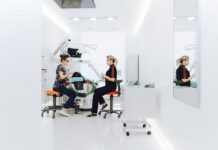An emergency room’s scientist in New York discovered how COVID-19 deprives the blood of oxygen, which enabled him to research on hyperbaric oxygen chambers as a potential treatment option.
In every corner of the world, COVID-19 cases are increasing and emergency rooms are filling up with only coronavirus patients. As the pandemic is growing and hitting a wide audience, the concerns of potential cure are also increasing. Currently, we are not even close to a promising treatment option or a vaccine.
Hence, scientists everywhere are looking for possible treatments that provide a small ray of hope for severe and critical COVID-19 cases, who have very low chances of survival.
One such treatment option was discovered by two New York scientists, David Lee and Scott Gorenstein. After closely studying the impact of cytokine storm in severe COVID-19 patients, both the experts found out that hyperbaric oxygen chambers can help in treating the hypoxia from the core.
In the following sections of the article, we have discussed how. Read on to know how hyperbaric oxygen therapy can offer a potential treatment to severe and critical patients of coronavirus.
How Hyperbaric Oxygen Chambers Work?
Before we move forward, let’s see how hyperbaric oxygen chambers function.
Under normal conditions, our body carries oxygen through red blood cells. Every organ, tissue, and cell receives oxygen through this medium.
When the body is in the hyperbaric oxygen chamber, the pressure is increased and 100% oxygen is delivered to the body. In a pressurized chamber, the oxygen dissolves in body fluids such as lipids, plasma, and cerebral spinal fluid. Due to this action, extra oxygen reaches damaged tissues, lungs, and other body organs and parts. This increase in oxygen helps in relieving multiple illnesses such as decompression sickness.
Even FDA has approved this therapy for 13 types of diseases such as burns, wounds, carbon monoxide poisoning, etc.
Fortunately, the therapy is non-invasive and has minimum side-effects as compared to other similar treatment options. It has fewer side-effects than other COVID-19 drugs and treatments as well.
The Research Conducted by David Lee and Scott Gorenstein
Dr. Lee and Gorenstein were worried about the situation of the emergency room at the hospital. With the cases of COVID-19 increasing, they still had no potential and promising treatment option at hand.
Hence, after some research on how hyperbaric oxygen chambers help in relieving symptoms of decompression sickness, Dr. Gorenstein and Lee found that the action can help in critical COVID-19 cases as well.
The biggest issue faced by severe coronavirus cases is hypoxemia and low oxygen level in the lungs, which is similar to issues faced in decompression sickness. When these patients are shifted to hyperbaric oxygen chambers, oxygen is directly delivered to affected areas such as lungs, organs, and other affected parts of the body. This relieves the symptoms of hypoxia directly. Therefore, offering a potential treatment to avoid intubation in critical cases.
Considering the beneficial impact of the hyperbaric oxygen chamber, Dr. Lee and Gorenstein conducted a small trial with 20 critical COVID-19 patients. After the trial, scientists discovered a recovery rate of 90%. This means that 18 patients who entered the trial have seen favorable results. These individuals had recovered at the end of the trial and they have returned home.
In the twenty patients that were treated with HBOT, every patient received relief with only the first 90-minute session.
When this group was compared to the control group, it was concluded that the hyperbaric oxygen chamber could reduce mortality and eliminate the need for ventilation in severe and critical COVID-19 cases.
While the hyperbaric oxygen chamber has not yet been tested and backed by leading pharmaceutical companies, it offers promising results. Both the drugs, remdesivir and hydroxychloroquine, have given hope but not in critical cases.
Patients, who are on the verge of intubation or are being shifted to a ventilator, observe very low relief from these treatment options. This is because, once the patient is being shifted to intubation, cytokine storm has already started and the oxygen level is low in the blood.
Hyperbaric oxygen chambers, on the other hand, help in relieving symptoms directly by delivering oxygen to the lungs.
However, there are some risk factors of hyperbaric oxygen chamber:
- The biggest risk is transferring the patient to and from the chamber. During this time, the patient can suffer adverse effects and also infect other patients.
- The pressure handled by every patient is different. So, it is risky to offer treatment without close scrutiny of trained medical professionals.
- It is necessary to properly disinfect chambers to avoid spreading the infection to other healthy patients. This is why, mostly, chambers used for COVID-19 patients are not used for other healthy patients.
- The chamber vents also pose a risk of infection. So, it should be checked beforehand that vents open in a place where other people are not at the risk of infection.
Conclusion
Even with the risks, hyperbaric oxygen chambers are beneficial for critical and severe COVID-19 patients. This therapy can provide a potential treatment option that is the need of the hour now.
However, since the therapy has risks, it is not advisable to use the hyperbaric oxygen chamber at home for COVID-19. You can infect other people or harm your body. Thus, reach out to a specialist for optimum care and consultation.












